
In even-numbered years voters in every state head to the polls in a federal election to cast ballots for U.S. Congress (every two years) and for president (every four years). In Tennessee, we also elect our state leaders at the same time – our state legislative representatives (the full state House and half of the state Senate) every two years and the governor every four years.
Next year, 2026, is a Midterm cycle (non-presidential federal election), which is also when Tennessee elects our governor. With Governor Lee term limited, the gubernatorial seat will be open, resulting in a new governor for our state.
That means that one year from today – August 6, 2026 – Tennesseans will vote in primary elections to choose party candidates for the governor, all 9 U.S. House of Representatives, 1 U.S. Senator, all 99 state House of Representatives, and the 16 odd-numbered state Senate seats. [1]
Based on historical trends, we can expect low voter turnout. But what can be done to change that?
Key Takeaways
- Midterm election cycles in Tennessee typically see lower turnout than presidential cycles. But within midterm cycles, those with an open gubernatorial seat (like 2026) tend to see higher turnout than those when an incumbent governor runs for re-election. [jump]
- Most of Tennessee’s recent closest races have come in the August primaries rather than the general elections, yet turnout has been particularly low in August elections. [jump]
- Turnout is driven by having more than one candidate on the ballot, and we’ve seen an increase in the number of state legislative candidates running. [jump]
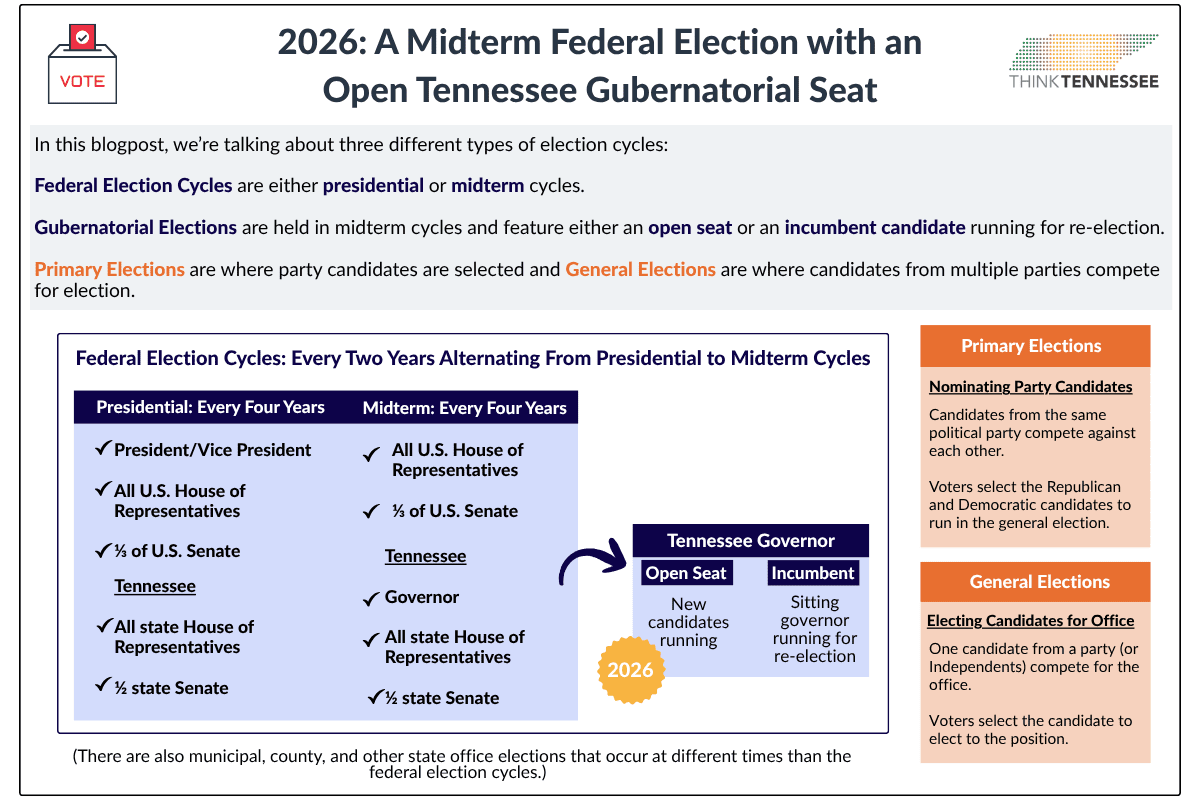
Voter turnout is lower in midterm than presidential cycles, but open gubernatorial elections see higher turnout than ones with incumbent candidates.
Historically, a smaller percentage of Tennessee’s registered voters participate during midterm election cycles than during presidential cycles. Most recently, 64.0% of registered voters participated in 2024’s presidential elections, and only 38.6% did so in 2022’s midterms – leading to Tennessee being ranked 51st, the lowest in the nation.[2]
However, midterm cycles when Tennessee has an open gubernatorial seat have seen higher participation than when an incumbent is seeking re-election.
With Governor Bill Lee termed out of office, next year’s gubernatorial election will be an open race with new candidates running. In recent years, these election cycles have seen higher turnout – though still lower than presidential cycles – than those where a governor is running for re-election.
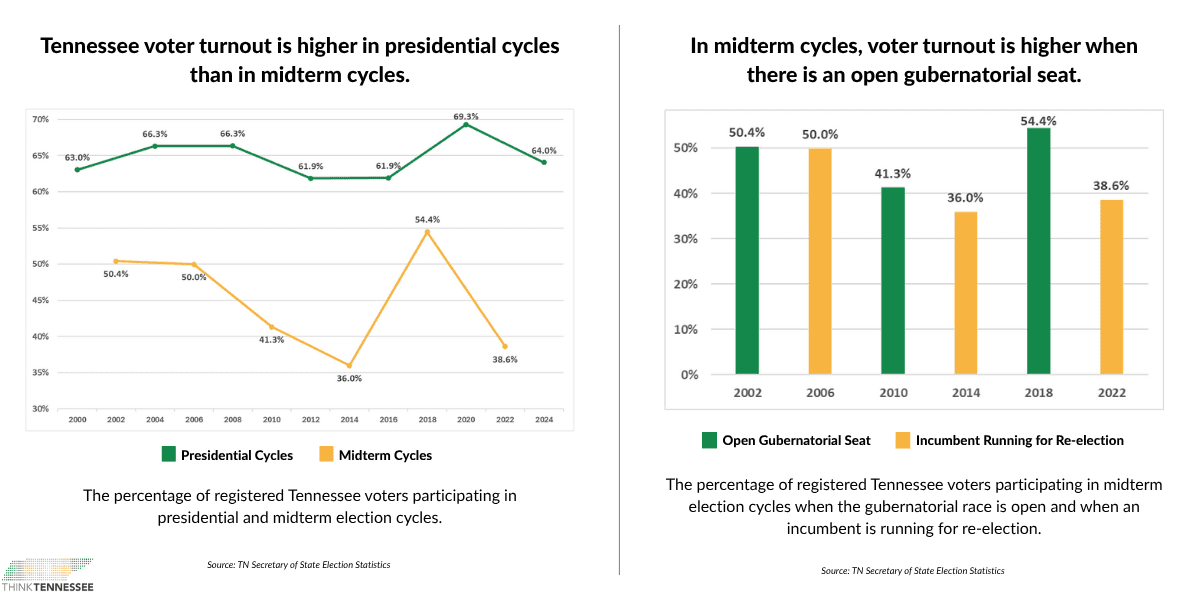
August’s primary races – to select the candidate to represent the party in November – have been the closest races in recent years, yet turnout is drastically lower than in November.
In recent cycles, August primaries have seen more competitive elections than November generals.
Smaller margins have determined Tennessee’s August primary elections than November general elections which have been less competitive. In the most recent (2024 and 2022) cycles, all but one of the closest races (5 of 6 in 2024 and 6 of 7 in 2022) came in August primaries – with some determined by fewer than 100 votes.
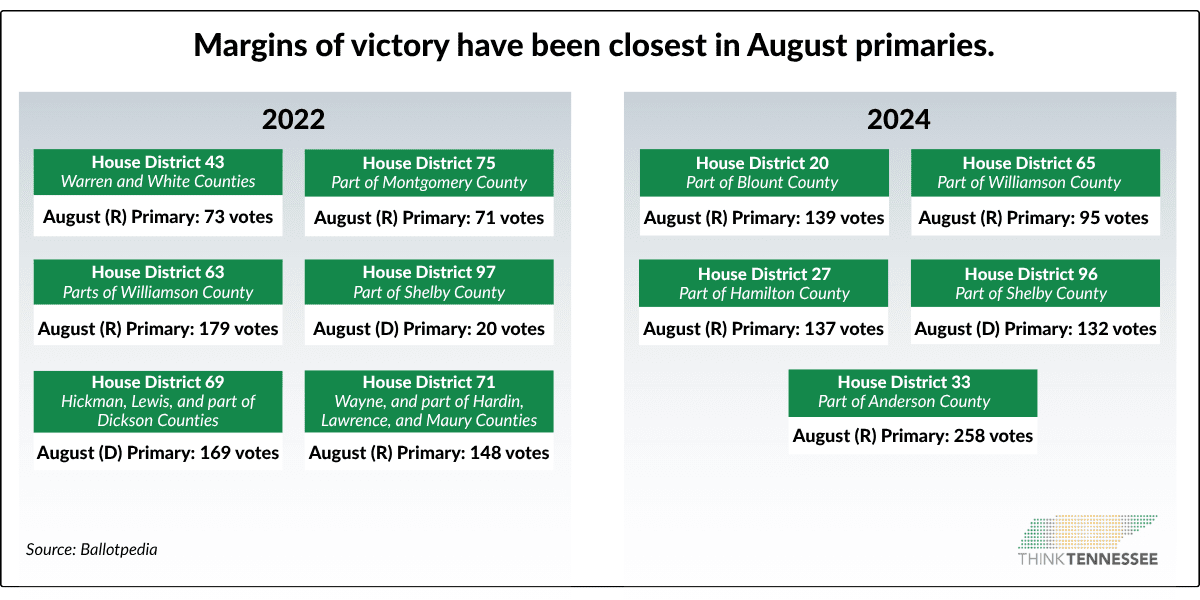
Particularly in districts that lean more heavily to one party, the August primary plays a larger role in determining who represents that district, as November general elections are determined with larger margins of victory.
Yet, turnout in August primaries is typically much lower than in November generals.
Regardless of whether it is a presidential or midterm election cycle, voter participation in Tennessee has been on average 33.4 percentage points lower in August primaries than in November general elections. However, August primary elections in midterm cycles have seen higher turnout rates than August primaries in presidential cycles.
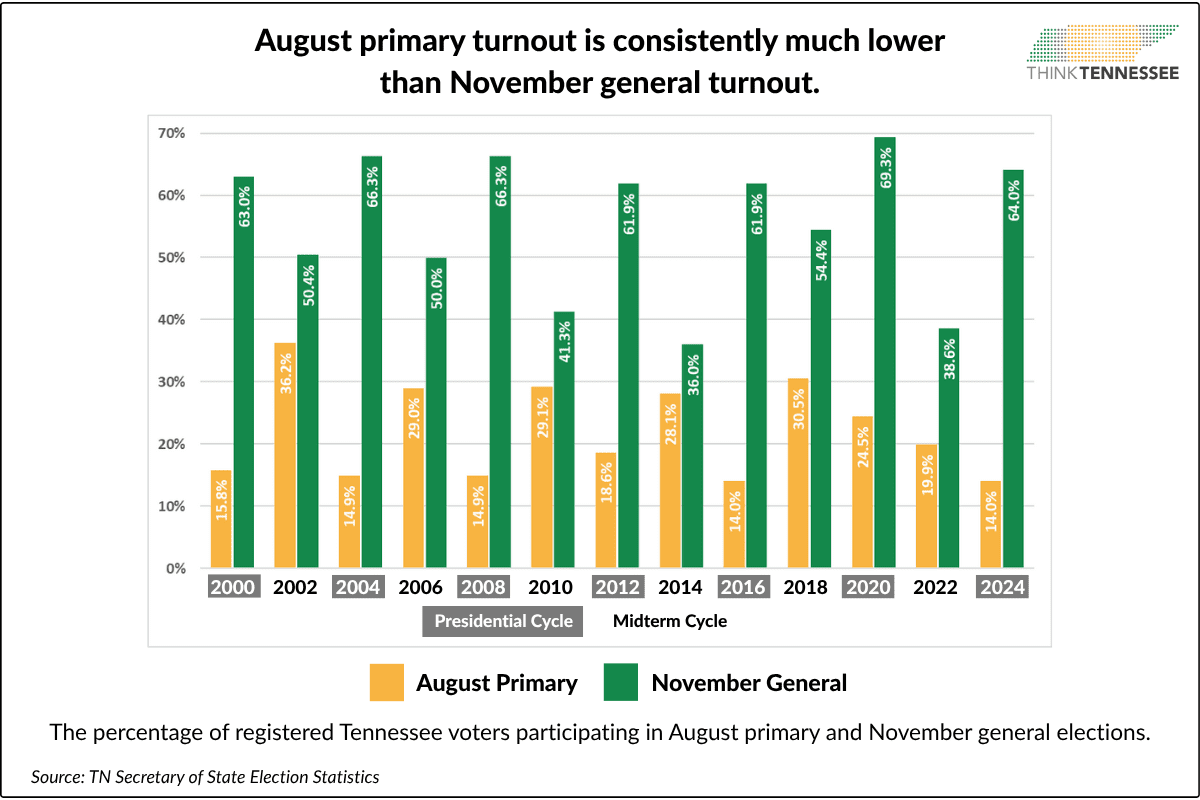
So, what can we expect in 2026?
If we stick to historical trends, we can anticipate low voter turnout in August.
Based on historic trends, 2026 will see lower voter turnout than we saw last year, and it will be one of the lowest in the country. The August primaries in particular will see only around 30% of registered voters participate.
However, we are one year out, and we have the opportunity to change our course.
If we want to see higher voter engagement in next year’s election cycle, in particular in August’s primaries, we can call on three groups to act between now and then:
Candidates: More candidates on the ballot drive higher voter turnout
Our analysis of historical Tennessee election statistics found that having more than one candidate on the ballot drives higher voter turnout. The good news is: in recent years, we have seen an increase in the number of state legislative seats being contested by both parties in August and November.[3]
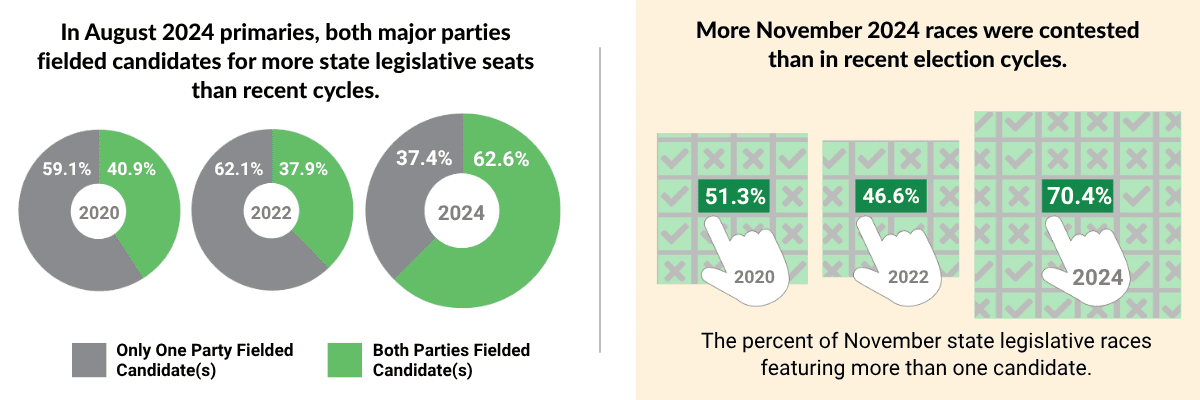
If this trend continues into 2026 – candidates from both parties run for more seats in August – we could see more voters have the chance to participate in a primary election. In addition to more races being contested by both parties, more qualified candidates on each of those party ballots provides more opportunity for voter engagement and attention as voters have a choice to make.
The candidate qualifying deadline for these races is March 10, 2026 at 12:00 noon.
Voters: Participation in August primaries determines who runs in November
Most of the focus on preparing for “Election Day” tends to be on the November general elections rather than the August primaries. Given the importance of primary elections in selecting candidates in Tennessee, advocates can focus voter registration, education, and engagement efforts to help drive awareness of and participation in the August 6 primary as well as the November general.
The voter registration deadline for August primaries is July 7, 2026.
Policymakers: Consider expanding opportunities for voters to participate
State election policies – from voter registration deadlines and how to vote absentee – differ from state to state (see Tennessee’s Election Laws in Context: A State-by-State Overview for more).
There are opportunities for Tennessee lawmakers to consider when they come back in session next year that could help expand voter engagement in 2026. For instance, Tennessee is one of 12 states with a voter registration deadline 30 days before Election Day. In the rest of the country, voters have more time to ensure they are registered, with 25 states and DC allowing Same Day Registration – where voters can register at their polling place. And Tennessee requires absentee voters to return their ballots by mail, whereas every other state except Mississippi also accepts absentee ballots returned in person to election officials to avoid potential mail delays.
What will Tennessee’s voter participation look like in next year’s federal election cycle? Only time will tell, but there is plenty of time to try to help encourage more Tennesseans to take part.
Endnotes
[1] There are also county and municipal elections on the calendar in 2026, with primary elections (if called) for county seats on May 5, 2026, and the general election for those seats also held on August 6, (at the same time as the primaries for the state and federal seats).
[2] This ranking is calculated as a percentage of the estimated voting eligible population not the percentage of registered voters. That percentage is 31.3%. https://elections.mit.edu/#/data/indicators
[3] However, even though more legislative seats on 2024 featured a Republican and Democratic primary race in August, most of those races only had one candidate on the ballot. So, while both a Republican and a Democratic voter could participate in August (as a candidate for each party was running), once they selected their party ballot, there was only one candidate to “choose.”




